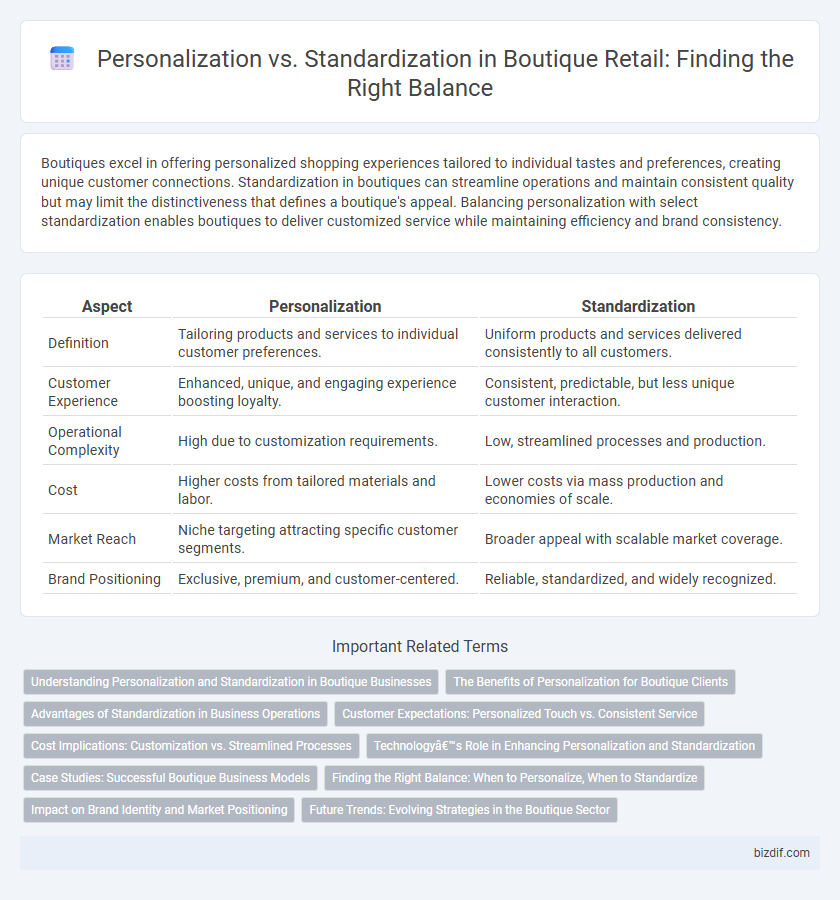Boutiques excel in offering personalized shopping experiences tailored to individual tastes and preferences, creating unique customer connections. Standardization in boutiques can streamline operations and maintain consistent quality but may limit the distinctiveness that defines a boutique's appeal. Balancing personalization with select standardization enables boutiques to deliver customized service while maintaining efficiency and brand consistency.
Table of Comparison
| Aspect | Personalization | Standardization |
|---|---|---|
| Definition | Tailoring products and services to individual customer preferences. | Uniform products and services delivered consistently to all customers. |
| Customer Experience | Enhanced, unique, and engaging experience boosting loyalty. | Consistent, predictable, but less unique customer interaction. |
| Operational Complexity | High due to customization requirements. | Low, streamlined processes and production. |
| Cost | Higher costs from tailored materials and labor. | Lower costs via mass production and economies of scale. |
| Market Reach | Niche targeting attracting specific customer segments. | Broader appeal with scalable market coverage. |
| Brand Positioning | Exclusive, premium, and customer-centered. | Reliable, standardized, and widely recognized. |
Understanding Personalization and Standardization in Boutique Businesses
Personalization in boutique businesses involves tailoring products, services, and customer experiences to individual preferences, enhancing customer satisfaction and loyalty. Standardization ensures consistent quality, operational efficiency, and brand reliability across all touchpoints, which is crucial for maintaining a strong market presence. Balancing personalization with standardization allows boutiques to deliver unique, customized experiences while maintaining scalable and efficient business practices.
The Benefits of Personalization for Boutique Clients
Personalization in boutiques enhances client satisfaction by tailoring products and services to individual preferences, resulting in a unique shopping experience that fosters loyalty. Customized offerings often lead to higher perceived value, encouraging repeat purchases and positive word-of-mouth referrals. Leveraging data on customer behavior allows boutiques to anticipate needs and deliver exclusive items, setting them apart from standardized retail models.
Advantages of Standardization in Business Operations
Standardization in boutique business operations ensures consistent product quality and customer experience, enhancing brand reliability and trust. Streamlined processes reduce operational costs and increase efficiency, allowing for easier scalability across multiple locations. Standardization simplifies inventory management and training, facilitating smoother workflows and faster decision-making.
Customer Expectations: Personalized Touch vs. Consistent Service
Boutique businesses thrive by balancing personalization and standardization to meet diverse customer expectations. Personalized touches, such as tailored recommendations and customized experiences, enhance customer satisfaction and loyalty by making shoppers feel valued and understood. Consistent service ensures reliability and builds trust, creating a dependable shopping environment that attracts repeat clientele while maintaining brand integrity.
Cost Implications: Customization vs. Streamlined Processes
Personalization in boutiques increases cost due to bespoke materials, specialized labor, and longer production times, impacting profit margins. Standardization reduces expenses through streamlined processes, bulk purchasing, and efficient workflows that enable consistent pricing and faster turnaround. Balancing customization benefits with operational efficiency is essential for sustainable boutique management.
Technology’s Role in Enhancing Personalization and Standardization
Advanced technologies such as artificial intelligence and machine learning enable boutiques to deliver hyper-personalized customer experiences by analyzing individual preferences and purchase history. Simultaneously, automation tools facilitate standardization by ensuring consistent product quality and efficient inventory management across multiple locations. This dual role of technology enhances operational efficiency while maintaining unique customer engagement in boutique retail environments.
Case Studies: Successful Boutique Business Models
Case studies of successful boutique business models reveal that personalization drives higher customer satisfaction and loyalty by tailoring products and services to individual preferences. Brands like Glossier utilize personalized marketing and customer feedback to create unique experiences that differentiate them from standardized competitors. This targeted approach often results in increased sales and stronger brand equity within niche markets.
Finding the Right Balance: When to Personalize, When to Standardize
Achieving the right balance between personalization and standardization in boutiques hinges on customer expectations and operational efficiency. Personalization enhances customer loyalty by tailoring products and experiences to individual preferences, while standardization ensures consistent quality and streamlined processes. Boutique owners should personalize when targeting niche markets or high-value clients and standardize routine offerings to maintain scalability and cost control.
Impact on Brand Identity and Market Positioning
Personalization in boutiques enhances brand identity by creating unique, tailor-made experiences that resonate deeply with niche customer segments, fostering strong brand loyalty. Standardization offers consistency and broad market appeal but may dilute the distinctiveness essential for a boutique's exclusive positioning. Balancing personalized offerings with scalable elements solidifies market positioning while preserving the boutique's unique brand essence.
Future Trends: Evolving Strategies in the Boutique Sector
Future trends in the boutique sector emphasize a shift toward hyper-personalization, leveraging AI and big data to tailor unique customer experiences and product offerings. Standardization remains relevant for operational efficiency but is increasingly integrated with personalized elements to create adaptive business models. The evolving strategy balances scalable processes with bespoke services, enhancing customer loyalty and competitive differentiation.
Personalization vs Standardization Infographic

 bizdif.com
bizdif.com